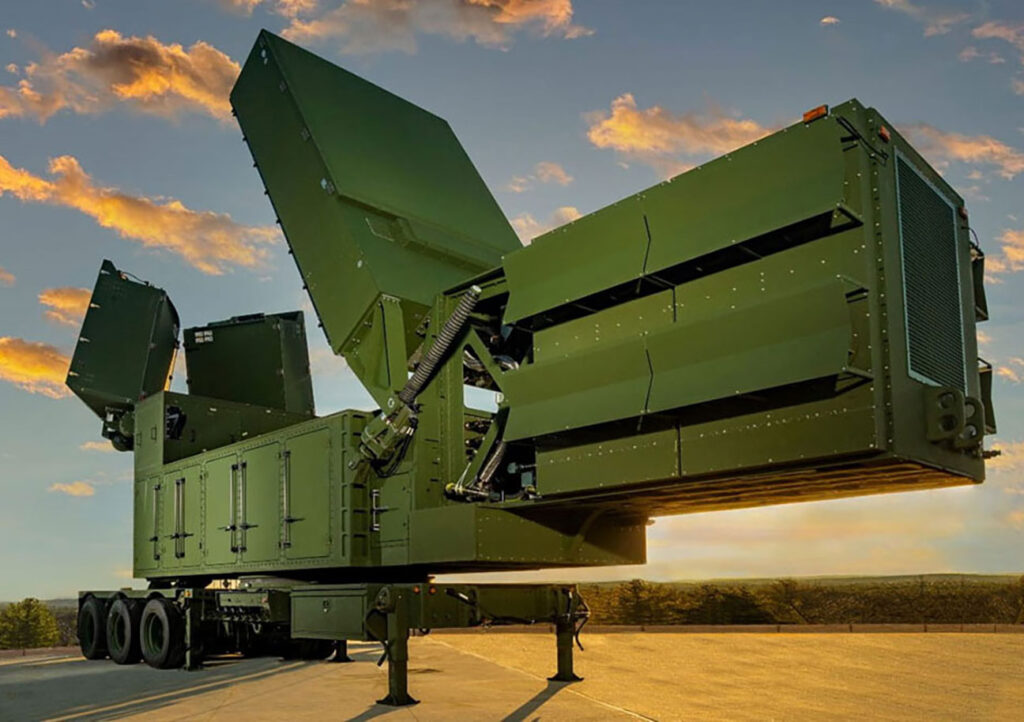The Lower Tier Air and Missile Defense Sensor is a radar system used to detect and defeat advanced threats, including ballistic and hypersonic weapons. U.S. ARMY
THE WATCH STAFF
A United States Army Space and Missile Defense Command (USASMDC) team’s low-cost target provided an operational assessment for the Army’s new Lower Tier Air and Missile Defense Sensor (LTAMDS) radar and the Soldiers who operated the system in a real-world scenario.
The Black Dagger short-range ballistic missile target launched from Fort Wingate, New Mexico, into White Sands Missile Range, New Mexico, in December 2024. Data showed the Black Dagger target was tracked by the LTAMDS radar and hit by an interceptor missile, said Cain Crouch, chief of the USASMDC Technical Center’s Targets Division. Data indicated the Black Dagger flight exceeded performance requirements, he said.
“LTAMDS is one of the most advanced radars in the world and will help our warfighters become more efficient in detecting incoming threats, ultimately saving lives on the battlefield,” Crouch said. “These missions provide real-world scenarios for Soldiers and hardware to operate within, which is unique outside of an actual wartime event,” he added. “I think it’s important to exercise the equipment and personnel in that manner. It really prepares them for seeing the same thing on the battlefield and prepares them to react accordingly, which saves warfighter lives day in and day out.”
The Army subsequently approved production and deployment of the LTAMDS radar in April 2025, aerospace and defense company Raytheon announced. “LTAMDS has completed eight successful flight tests of increasing complexity to stress the radar and prove its capabilities against real-world threats,” a Raytheon news release said. “This led the Army to validate that the radar has reached Milestone C, initiating the production and deployment phase of the program.”
LTAMDS is set to replace the current Patriot radar system, which is 4 decades old, but also will preserve existing military customers’ investment in the Patriot system. The primary LTAMDS array is about the same size as that of the Patriot air and missile defense system, but it has more than twice the power.
Raytheon won the bid on a $384 million contract, allowing the company to build six LTAMDS radars, which it has delivered, the global defense website Breaking Defense reported. Raytheon plans to deliver two more radars in 2025 and move toward producing eight LTAMDS per year.
In September 2023, Poland announced it had agreed to purchase 12 of the radars, becoming the first international buyer. A dozen other countries have requested information on the system and are “receiving pricing and availability estimates,” Raytheon said.
Justin Novak, USASMDC target test director for the Black Dagger mission, said the testing of missile defense systems against strategic missile threats builds confidence that these systems will perform as designed to ensure the safety and security of the U.S., allies and partners.
“The successful launch of this target allowed the Soldier-operated integrated missile defense system to successfully track and engage a ballistic missile, demonstrating the system’s readiness for fielding,” Novak said. “The successful demonstration of integrated air and missile defense systems to engage Black Dagger targets increases Soldier confidence that, when the time comes, they will be able to successfully defend against ballistic missile threats both at home and abroad.”
Olivia Miller, pad chief for the mission, operated the fixed target launcher during the launch and adjusted the launcher during the countdown, as weather balloon data was received.
“There’s a great sense of accomplishment when these missions are successful because we are seeing hundreds of hours of mission prep come to fruition,” Miller said. “But a successful target launch is just the first half of the mission; seeing LTAMDS track and intercept our vehicle makes the day truly rewarding. These missions are important because with each successful test, LTAMDS is getting closer to being deployed to support the warfighter.”

